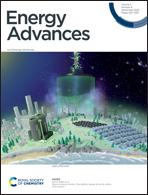Construction of Co3(PO4)2/g-C3N4 nanowire composites to boost visible-light-driven photocatalysis
Abstract
Co3(PO4)2/g-C3N4 nanowire composites are prepared by calcining a certain amount of melamine and cobalt phosphate (CPO) nanowires at 550 °C in a nitrogen environment, forming a heterojunction structure of Co3(PO4)2 nanowires with a size of 10–20 nm embedded in g-C3N4 (CN) sheets. The introduction of Co3(PO4)2 nanowires broadens the visible light absorption range of g-C3N4, increases the specific surface area, and greatly enhances the transfer and separation of photogenerated charge carriers. Under visible light irradiation, the hydrogen evolution rate of the 15CPO–CN photocatalyst (10 mg) reached an optimal value of up to 29.31 μmol h−1, about 10 times that of pure CN (2.89 μmol h−1) and it showed enhanced antibacterial activity for removing E. coli as well. The synergic effect of the heterojunction between CPO nanowires and CN sheets accelerates the charge separation and transfer from CN to CPO, thus improving the photocatalytic activity.



 Please wait while we load your content...
Please wait while we load your content...